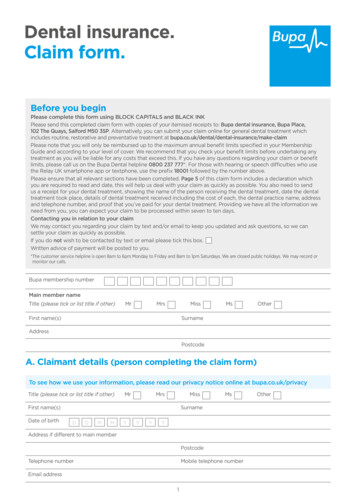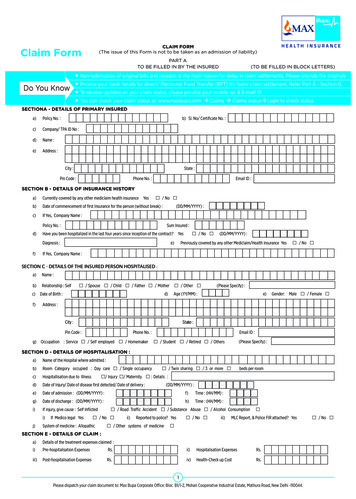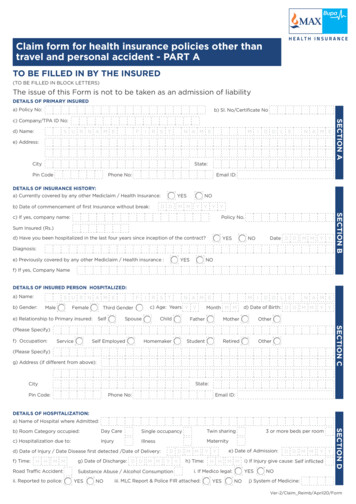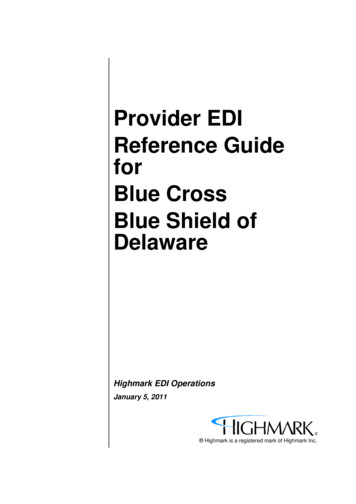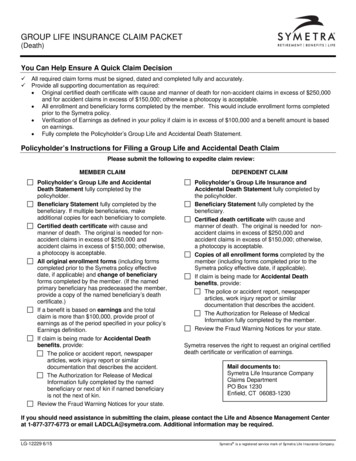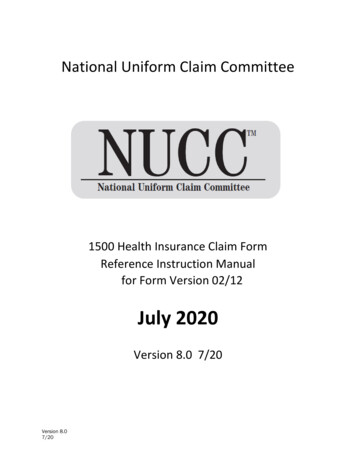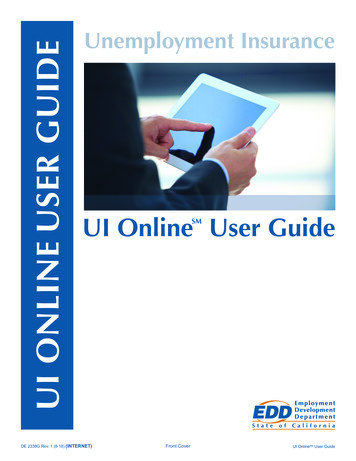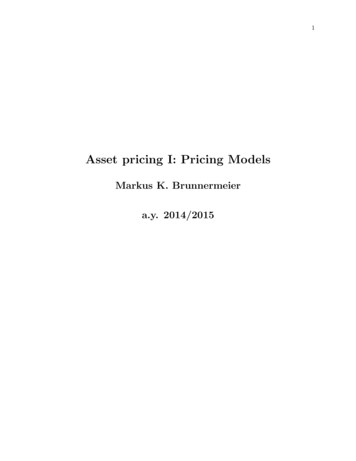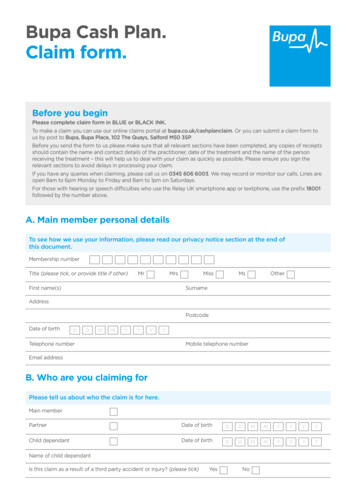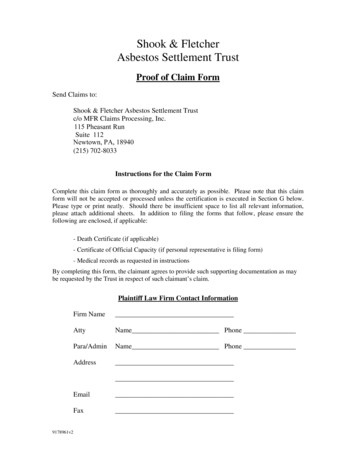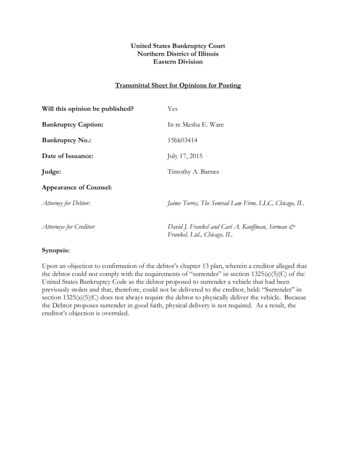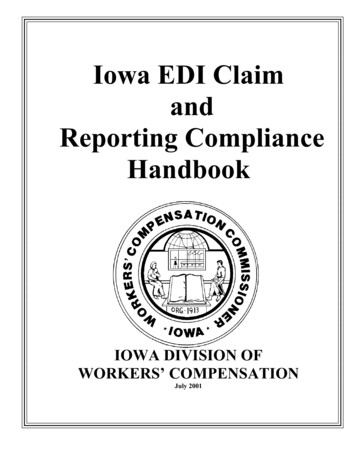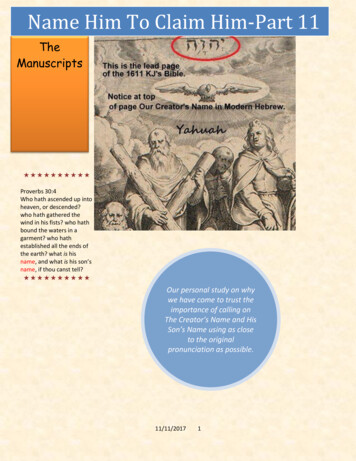
Transcription
Name Him To Claim Him-Part 1111/11/2017TheManuscripts Proverbs 30:4Who hath ascended up intoheaven, or descended?who hath gathered thewind in his fists? who hathbound the waters in agarment? who hathestablished all the ends ofthe earth? what is hisname, and what is his son’sname, if thou canst tell? Our personal study on whywe have come to trust theimportance of calling onThe Creator’s Name and HisSon’s Name using as closeto the originalpronunciation as possible.11/11/20171
Items of DiscussionPart 1Part 2Part 3Part 4Part 5Part 6Part 7Part 8Part 9Part 10Part 11Part 12Part 13Part 14Part 15The Only Opinion That Matters Is Yahuah’sYHWH-The Name The Cover UPThe Tetragrammaton-Wicked or Set Apart-Which Came First?The Hebrew Roots/Scared Name/Messianic MovementThe Kabala/Freemasons And The KJVThe Initial Breaking of The 3rd InstructionThe Tanakh Scriptures On The Importance of Yahuah’s NameHistorical Names In The Tanakh/Eye Witness AccountsArcheological Evidence for The Names In The TanakhDe-Greecing The Names And Hebrew ThoughtThe ManuscriptsJew/Gentile. Who Are The Scriptures Talking To?Is The Way To Salvation Through A Specific Name?Having A Truth Seeking Spirit No Matter Where The Truth LeadsResourcesPart 12The Manuscripts-Scripture TranslationsWe wanted to show in this part the vast array of Manuscripts as well astranslations of the Scriptures we have. We were unaware that we didn’t have acomplete Tanakh and Eye Witness Accounts from the authors. We don’t thinkabout where we really get our Scriptures from and the 1,000’s of hands they mayhave passed through to get our current translations. Questions like whichmanuscripts were oldest or most complete or accurate just brought more11/11/20172
questions. So we are just going to scrape the top of the surface with this. Atsome later date we may provide a more detailed coverage of the manuscripts or insome cases just fragments of what comprises our Scriptures. But we can tell younot all English bibles are translated from the same sources. There is newinformation coming to light everyday so we are going to present this study as awork in progress as more information comes to light especially with theSeptuagint or LXX.To just rely on a single English translation can cause some misconceptions ofScripture meaning and at worst completely miss the beautiful pictures of whatthe Hebrew originally said, but just because a Scripture is in Hebrew does notmake it without issues. This may sound confusing and hopeless, but we hope youwill look at this as a personal treasure hunt and let the Ruach ha Qodesh help tosort it out.The good news is a lot of Scripture does agree within itself, although there canbe up to 30,000 variations of spelling, words, additions and subtractions. So whenyou find the gems, it really opens things up. hwhy has left these for the seekersof truth to find. If this were not so, then why tell us to keep searching and thenpromise us we would find things. The only way to know hwhy is to search theScriptures. So it makes perfect sense that He has not made it too easy for us, sothat it’s reserved for those who truly do as He says. Toward the end of this part,we will provide some amazing translational issues in the Greek that the Aramaicputs right. There is some evidence that points to the Eyewitness Accounts inAramaic was written before that Greek and the Greek was translated from it. Agood source of information on this subject is Andrew Gabriel Roth and again we donot agree with all that he says, but what he does prove out in Scripture hasenriched our personal views of a lot of passages.11/11/20173
Some Competing Ideas of The Timeline of Bible Translation History Creation - B.C. 2000 - Originally, the earliest Scriptures are handed down from generationto generation orally. We know Adam and Enoch wrote before the flood but this view is notentertained in modern theology so they will lay it out as follows: Circa B.C. 2000-1500 - The book of Job, perhaps the oldest book of the Bible, iswritten.Circa B.C. 1500-1400 - The stone tablets of the Ten Instructions are given to Mosesat Mount Sinai and later stored in the Ark of the Covenant. 1,400 BC: The first written Word of Yahuah: The Ten Instructions delivered to Moshe.11/11/20174
1,000 BC- 500 BC Peshitta TanakhThe Peshitta Tanakh is the ancient Scriptures translated into Lishana Aramaya(Aramaic language) from the original Hebrew text which pre-dated the GreekSeptuagint text (LXX). The Aramaic Tanakh uses many Hebraic terms, many timestransliterating the words and phrases rather than translating them. Often times theAramaic Peshitta and the LXX agree against the Masoretic text. The Masoretic text isnot the original Hebrew that was used by the translators of the Aramaic Peshitta. Inother words, the text used by those who translated the Aramaic Pshitta is much olderthan the Masoretic text. The Aramaic Peshitta Tanakh was completed during theApostolic Age (first century), while the standardized Masoretic text was completedbetween the seventh and tenth centuries C.E. These Scriptures are still used byHebrew-Aramaic speaking peoples for study of the Scriptures and use in liturgy in theEast.Circa B.C. 1400–400 - The manuscripts comprising the original Hebrew Bible (39 OldTestament books) are completed. The Book of the Law is kept in the tabernacle andlater in the Temple beside the Ark of the Covenant11/11/20175
500 BC: Completion of All Original Hebrew Manuscripts which make up The 39Books of the Tanakh. Circa B.C. 300 - All of the original Old Testament Hebrew books have been written,collected, and recognized as official, canonical books.200 BC: Completion of the Septuagint Greek Manuscripts which contain The 39 TanakhBooks AND 14 Apocrypha Books. Circa B.C. 250–200 - The Septuagint, a popular Greek translation of the Hebrew Bible (39Old Testament books), is produced. The 14 books of the Apocrypha are also included.50-70AD The Peshitta (Aramaic)New Testament -The twenty-two books of the “NewTestament” were originally written in Aramaic using K'tav Ashuri (square Hebrew script). Circa A.D. 45–100 - Original 27 books of the Greek New Testament are written.1st Century AD: Completion of All Original Greek Manuscripts which make up The 27Books of the “New Testament” Circa A.D. 140-150 - Marcion of Sinope's heretical "New Testament" promptedOrthodox Christians to establish a New Testament canon.Circa A.D. 200 - The Jewish Mishnah, the Oral Torah, is first recorded.Circa A.D. 240 - Origen compiles the Hexapla, a six-columned parallel of Greek andHebrew texts.Circa A.D. 305-310 - Lucian of Antioch's Greek New Testament text becomes thebasis for the Textus Receptus.Circa A.D. 312 - Codex Vaticanus is possibly among the original 50 copies of theBible ordered by Emperor Constantine. It is eventually kept in the Vatican Library inRome.315 AD: Athenasius, the Bishop of Alexandria, identifies the 27 books of the “NewTestament” which are today recognized as the canon of scripture. A.D. 367 - Athanasius of Alexandria identifies the complete New Testament canon (27books) for the first time.11/11/20176
382 AD: Jerome's Latin Vulgate Manuscripts Produced which contain All 80 Books (39Tanakh. 14 Apocrypha 27 “New Test”). A.D. 382-384 - Saint Jerome translates the New Testament from original Greek intoLatin. This translation becomes part of the Latin Vulgate manuscript.A.D. 397 - Third Synod of Carthage approves the New Testament canon (27 books).A.D. 390-405 - Saint Jerome translates the Hebrew Bible into Latin and completes the LatinVulgate manuscript. It includes the 39 Old Testament books, 27 New Testament books, and14 Apocrypha books.500 AD: Scriptures have been Translated into Over 500 Languages. A.D. 500 - By now the Scriptures have been translated into multiple languages, not limited tobut including an Egyptian version (Codex Alexandrinus), a Coptic version, an Ethiopictranslation, a Gothic version (Codex Argentus), and an Armenian version. Some consider theArmenian to be the most beautiful and accurate of all ancient translations.11/11/20177
600 AD: LATIN was the Only Language Allowed for Scripture. A.D. 600 - The Roman Catholic Church declares Latin as the only language for Scripture.A.D. 680 - Caedmon, English poet and monk, renders Bible books and stories into AngloSaxon poetry and song.A.D. 735 - Bede, English historian and monk, translates the Gospels into Anglo Saxon.A.D. 775 - The Book of Kells, a richly decorated manuscript containing the Gospels and otherwritings, is completed by Celtic monks in Ireland.Circa A.D. 865 - Saints Cyril and Methodius begin translating the Bible into Old ChurchSlavonic.A.D. 950 - The Lindisfarne Gospels manuscript is translated into Old English.995 AD: Anglo-Saxon (Early Roots of English Language) Translations of“The NewTestament” Produced. Circa A.D. 995-1010 - Aelfric, an English abbot, translates parts of Scripture into OldEnglish.A.D. 1205 - Stephen Langton, theology professor and later Archbishop of Canterbury, createsthe first chapter divisions in the books of the Bible.A.D. 1229 - Council of Toulouse strictly forbids and prohibits lay people from owning a Bible.A.D. 1240 - French Cardinal Hugh of Saint Cher publishes the first Latin Bible with thechapter divisions that still exist today.A.D. 1325 - English hermit and poet, Richard Rolle de Hampole, and English poet WilliamShoreham, translate the Psalms into metrical verse.Circa A.D. 1330 - Rabbi Solomon ben Ismael first places chapter divisions in the margins ofthe Hebrew Bible.A.D. 1381-1382 - John Wycliffe and associates, in defiance of the organized Church,believing that people should be permitted to read the Bible in their own language, begin totranslate and produce the first handwritten manuscripts of the entire Bible in English. Theseinclude the 39 Old Testament books, 27 New Testament books, and 14 Apocrypha books.1384 AD: Wycliffe is the First Person to Produce a (Hand-Written) manuscript Copy ofthe Complete Bible; All 80 Books. A.D. 1388 - John Purvey revises Wycliffe's Bible.A.D. 1415 - 31 years after Wycliffe's death, the Council of Constance charges him with morethan 260 counts of heresy.A.D. 1428 - 44 years after Wycliffe's death, church officials dig up his bones, burn them, andscatter the ashes on Swift River.1455 AD: Gutenberg Invents the Printing Press; Books May Now be mass-ProducedInstead of Individually Hand-Written. The First Book Ever Printed is Gutenberg's Bible inLatin. A.D. 1455 - After the invention of the printing press in Germany, Johannes Gutenbergproduces the first printed Bible, the Gutenberg Bible, in the Latin Vulgate.11/11/20178
1516 AD: Erasmus Produces a Greek/Latin Parallel “New Testament”. A.D. 1516 - Desiderius Erasmus produces a Greek New Testament, forerunner to the TextusReceptus.A.D. 1517 - Daniel Bomberg's Rabbinic Bible contains the first printed Hebrew version(Masoretic text) with chapter divisions.1522 AD: Martin Luther's German “New Testament”. A.D. 1522 - Martin Luther translates and publishes the New Testament for the first time intoGerman from the 1516 Erasmus version.A.D. 1524 - Bomberg prints a second edition Masoretic text prepared by Jacob ben Chayim.A.D. 1525 - William Tyndale produces the first translation of the New Testament from Greekinto English.1526 AD: William Tyndale's New Testament; “The First New Testament” printed in theEnglish Language. A.D. 1527 - Erasmus publishes a fourth edition Greek-Latin translation.A.D. 1530 - Jacques Lefèvre d'Étaples completes the first French language translation of theentire Bible.1535 AD: Myles Coverdale's Bible; The First Complete Bible printed in the English Language(80 Books: Tanakh & N.T. & Apocrypha). Third oldest English bible was promoted by Cloverdale,although he copied Tyndale word for word. A.D. 1535 - Myles Coverdale's Bible completes Tyndale's work, producing the first completeprinted Bible in the English language. It includes the 39 Old Testament books, 27 NewTestament books, and 14 Apocrypha books.A.D. 1536 - Martin Luther translates the Old Testament into the commonly-spoken dialect ofthe German people, completing his translation of the entire Bible in German.1537 AD: Tyndale-Matthews Bible; The Second Complete Bible printed in English. Done byJohn "Thomas Matthew" Rogers (80 Books). A.D. 1537 - The Matthew Bible (commonly known as the Matthew-Tyndale Bible), a secondcomplete printed English translation, is published, combining the works of Tyndale, Coverdaleand John Rogers.11/11/20179
1539 AD: The "Great Bible" Printed; The First English Language Bible Authorized for PublicUse (80 Books). For King Henry the VIII. A.D. 1539 - The Great Bible, the first English Bible authorized for public use, is printed.1560 AD: The Geneva Bible Printed; The First English Language Bible to add NumberedVerses to Each Chapter (80 Books). A.D. 1560 - The Geneva Bible is printed in Geneva, Switzerland. It is translated by Englishrefugees and published by John Calvin's brother-in-law, William Whittingham. The GenevaBible is the first English Bible to add numbered verses to the chapters. It becomes the Bible ofthe Protestant Reformation, more popular than the 1611 King James Version for decades afterits original release.1568 AD: The Bishops Bible Printed; The Bible of which the King James was a Revision (80Books). For Queen Elizabeth. A.D. 1568 - The Bishop's Bible, a revision of the Great Bible, is introduced in England tocompete with the popular but "inflammatory toward the institutional Church" Geneva Bible.A.D. 1582 - Dropping its 1,000-year-old Latin only policy, the Church of Rome produces thefirst English Catholic Bible, the Rheims New Testament, from the Latin Vulgate.A.D. 1592 - The Clementine Vulgate (authorized by Pope Clementine VIII), a revised versionof the Latin Vulgate, becomes the authoritative Bible of the Catholic Church.1609 AD: The DouayTanakh is added to the Rheims New Testament (of 1582) Making theFirst Complete English Catholic Bible; Translated from the Latin Vulgate (80 Books). A.D. 1609 - The Douay Old Testament is translated into English by the Church of Rome, tocomplete the combined Douay-Rheims Version.1611 AD: The King James Bible Printed; Originally with All 80 Books. The Apocrypha wasOfficially Removed in 1885 Leaving Only 66 Books. A.D. 1611 - The King James Version, also called the "Authorized Version" of the Bible ispublished. It is said to be the most printed book in the history of the world, with more thanone billion copies in print.A.D. 1663 - John Eliot's Algonquin Bible is the first Bible printed in America, not in English,but in the native Algonquin Indian language.1782 AD: Robert Aitken's Bible; The First English Language Bible (KJV) Printed in America. A.D. 1782 - Robert Aitken's Bible is the first English language (KJV) Bible printed in America.A.D. 1790 - Matthew Carey publishes a Roman Catholic Douay-Rheims Version English Biblein America.A.D. 1790 - William Young prints the first pocket sized "school edition" King James VersionBible in America.11/11/201710
1791 AD: Isaac Collins and Isaiah Thomas Respectively Produce the First Family Bible andFirst Illustrated Bible Printed in America. Both were King James Versions, with All 80 Books. A.D.A.D.A.D.A.D.1791179117911791-The Isaac Collins Bible, the first family Bible (KJV), is printed in America.Isaiah Thomas prints the first illustrated Bible (KJV) in America.The Isaac Collins Bible, the first family Bible (KJV), is printed in America.Isaiah Thomas prints the first illustrated Bible (KJV) in America.1808 AD: Jane Aitken's Bible (Daughter of Robert Aitken); The First Bible to be Printed bya Woman. A.D. 1808 - Jane Aitken (daughter of Robert Aitken), is the first woman to print a Bible.1833 AD: Noah Webster's Bible; After Producing his Famous Dictionary, Webster Printedhis Own Revision of the King James Bible. A.D. 1833 - Noah Webster, after publishing his famous dictionary, releases his own revisededition of the King James Bible.1841 AD: English Hexapla “New Testament”; an Early Textual Comparison showing theGreek and 6 Famous English Translations in Parallel Columns. A.D. 1841 - The English Hexapla New Testament, a comparison of the original Greeklanguage and six important English translations, is produced.A.D. 1844 - The Codex Sinaiticus, a hand written Koine Greek manuscript of both Old andNew Testament texts dating back to the fourth century, is rediscovered by German Biblescholar Konstantin Von Tischendorf in the Monastery of Saint Catherine on Mount Sinai.A.D. 1844 - Brenton’s Septuagint English Translation1846 AD: The Illuminated Bible; The Most Lavishly Illustrated Bible printed in America. AKing James Version, with All 80 Books.1885 AD: The "English Revised Version" Bible; The First Major English Revision of theKJV. A.D. 1881-1885 - The King James Bible is revised and published as the Revised Version (RV)in England.1901 AD: The "American Standard Version"; The First Major American Revision of the KJV. A.D. 1901 - The American Standard Version, the first major American revision of the KingJames Version, is published.A.D. 1946-1952 - The Revised Standard Version is published.A.D. 1947-1956 - The Dead Sea Scrolls are discovered.11/11/201711
1971 AD: The "New American Standard Bible" (NASB) is Published as a "Modern andAccurate Word for Word English Translation" of the Bible. A.D. 1971 - The New American Standard Bible (NASB) is published.1973 AD: The "New International Version" (NIV) is Published as a "Modern and AccuratePhrase for Phrase English Translation" of the Bible. A.D. 1973 - The New International Version (NIV) is published.1982 AD: The "New King James Version" (NKJV) is Published as a "Modern EnglishVersion Maintaining the Original Style of the King James." A.D. 1982 - The New King James Version (NKJV) is published.A.D. 1986 - The discovery of the Silver Scrolls, believed to be the oldest Bible textever, is announced. They were found three years earlier in the Old City of Jerusalemby Gabriel Barkay of Tel Aviv University.A.D. 1996 - The New Living Translation (NLT) is published.A.D. 2001 - The English Standard Version (ESV) is published.2002 AD: The English Standard Version (ESV) is Published as a translation to bridge thegap between the accuracy of the NASB and the readability of the NIV.This English Bible History Article & Timeline is 2002 by author & editor: John L. Jeffcoat III.Special thanks is also given to Dr. Craig H. Lampe for his valuable contributions to the text. This pagemay be freely reproduced or quoted, in whole or in part, in print or electronically, under the onecondition that prominent credit must be given to “WWW.GREATSITE.COM” as the source.11/11/201712
This of course does not include all the other languages that the Scriptures havebeen translated into, and all the Scriptures since then have been produced bypeople who knew Yahuah’s Name. What a blessing that is!We find it interesting to hear that calling on the Name of hwhy is somehow a newidea. It’s unfortunate, if it had not been for the prejudices of one being thought‘Jewish’ as we see below in as early as 1095 and those that wanted to know whatthe Scriptures really said in Hebrew who paid a high price for it we may havenothing. Shatan has been working overtime but hwhy is still on the throne! Here area few interesting things about the languages and Scriptures you may not know.11/11/201713
An event which occurred in 1290 tended to advance the study of Hebrew. Becauseof a sudden expulsion of the Jews from England by Edward the I., their HebrewManuscripts, was necessarily exposed to sale. Many of these fell into the hands ofGregory of Huntington, who became well acquainted with Rabbinic literature, andbequeathed them together with his own writings to Ramsay Monastery. A roll inthe British Museum, written perhaps as late as the reign of Rich II., is a catalogof the library of Ramsey Abbey.Among the works are:- Secunda pars biblliotecae ebraicae Glose sup. Bibliotecamhebraicam,. loquendi intelligendi in lingua hebraica, Prima pars bibliotecaehebraciae cum aliis septem libris, secunda pars bibliotecae ebraicae, liber expos.Distinctionem hebraicarum, ps hebraei. besides others with nearly defacedtitles.This was about the year 1250. Here they were diligently studied by the monks,among whom Robert Dodford and Lawrence Holbeck attained celebrity for theirHebrew learning. Indeed, the latter compiled a Hebrew Lexicon- the firstprobably ever produced by an Englishman.Many other Jewish works came into the possession of Roger Bacon and theFranciscan friars of Oxford University, who duly prized them and left them tothat institution.But these advances in the study of Hebrew were not made without difficulty andeven danger. The hatred exhibited itself in the decrees of various councils, asthose of Vienna, Mascon, Narbonne, Epasne, Beriers, Arragon and Todedo whichforbade Christians to eat with Jews, or even to employ them as physicians;- in thecruel persecutions to which they were exposed;- in the wanton destruction oftheir Manuscripts.;- and in a determined opposition to the study of their language.In the statutes of the Cistercjans, A.D. 1095, mention is made of a certain monkdirected to be examined and punished by the Abbott of Clair Vaux for havinglearned Hebrew from a Jew. This hatred which led to the expulsion of the Jews,manifested itself in the utmost dislike and opposition to all who attempted tomake any acquaintance with their literature. The knowledge of Greek and Hebrewwhich Roger Bacon possessed was regarded as the medium of his intercourse with11/11/201714
satanic agents. Cheke, the Greek lecturer at Cambridge, in a letter to the Bishopof Winton, plainly declares that “many reprove the study of Hebrew” and that “itis as much as one’s credit and reputation are worth to attempt the knowledge ofit”. Even the enlightened Erasmus did not hesitate to say- “I fear that the studyof Hebrew will promote Judaism”. Erasmus was upwards of fifty years old whenhe made this statement. These evidences of prejudices against the study ofHebrew are chiefly valuable as showing existence of Hebrew scholarship at thattime.Before long the sanction of the church which had been desired by Roger Bacon,was granted. In 1311 Clement published a decree ordering that professors ofGreek, Hebrew, Arabic and Chaldee should be established in the universities ofParis, Oxford, Bologna and Salamanea. This decree, if not immediately carried out,would yet in an age of implicit obedience to ecclesiastical authority, tend in somedegree to remove objections to the pursuit of these studies.But the study of the original languages of the Bible probably received its greatestimpulse from the Reformation, which did much to cause the prejudices which hadbeen noticed to disappear, and to deepen the desire of the people to have theword of Yahuah in their own tongue.Henry VIII, who had been informed that one of the university preachers atOxford had expressed himself with great violence against the study of theScriptures in the original, issued an order commanding that the “said study of theGreek and Hebrew Scriptures should not be permitted, but made an indispensablebranch of the course of academic instruction.”This royal command led to the founding in 1530 of a Hebrew professorship inOxford, - the first Hebrew professorship instituted in England. RobertWakefield, who had taught Hebrew in Louvain and Tabingen, and was now givinginstruction in the same language to the members of the University of Cambridge,was summoned from the latter place to fill this important station. In the requestof the University of Oxford urging Wakefield’s appointment, they say of him, “Hegives place to none for his knowledge in the Hebrew, Syriac and Arabic tongues.”John de Bristol, a converted Jew, taught Hebrew in Oxford, or “magnoscholariumplausu plures anno seam obibat”. In 1345 Richard Augerville, Bishop of Druharm,wrote his Philobiblion, in which he expresses his regret at the general ignoranceof Hebrew and Greek which prevailed, and adds that he had provided for the use11/11/201715
of students both Greek and Hebrew grammars. Nine years later, William Breton,of St. Edmundsburg wrote a treatise on the Hebrew names in the Old Testament.At the commencement of the fifteenth century, Adam Eason translated the OldTestament from Hebrew into Latin, except the Psalter, and wrote several workson Hebrew literature. Still later traces of this study are seen at Oxford. In 1491,Tonstal an excellent Hebrew scholar was a student at Oxford. There, too, it isprobable R. Sherwode, Prof. of Hebrew at Louvain in 1519 acquired his knowledgeof that language. John Helyar certainly did, who was a fellow prob. A.D. 1522.”F.C. BurkettHow The Name Jehovah Got Into The Scriptures By Mistake in 1518:A sixteenth century German scribe, Peter Gallatin, confessor to Pope Leo X, whiletransliterating the Bible into Latin for him in 1518, wrote the Name out as it appeared in histexts, with the consonants of YHWH and the vowels of Adonai, and came up with the wordJeHoVaH. This invalid name has been widely circulated in Christian churches, to the point it iswidely regarded by most to be the name of God.as used in Webster's New World Dictionary:College Edition states (on pages 766-767 and p. 1657)In the Septuagint (written in Greek) which was used in the early Assembly, the Name ofYahweh was written in Hebrew into the text in gold Hebrew letters. Being ignorant of Hebrew,the readers of the text transliterated it incorrectly into Latin.Dr. J.B. Rotherham states in the preface of his Bible concerning the name 'Jehovah'“Erroneously written and pronounced Jehovah, which is merely a combination of the sacredTetragrammaton and the vowels in the Hebrew word for Lord, substituted by the Jews forJHVH, because they shrank from pronouncing the Name, owing to an old misconception of thetwo passages, Exodus 20:7 and Leviticus 24:16 . To give the name JHVH the vowels of theword Lord [ Heb Adonai] is about as hybrid a combination as it would be to spell the nameGermany with the vowels of the name Portugal – viz., Gormuna. The monstrous combinationJehovah is not older than about 1520 A.D.”The Encyclopedia Britannica (Micropedia, vol.10) says, “Yahweh – the personal name of the[El] of the Israelites . the Masorites, Jewish biblical scholars of the Middle Ages, replaced thevowels signs that had appeared above or beneath the consonants of YHWH with the vowelsigns of Adonai or of Elohim. Thus the artificial name of Jehovah (YeHoWaH) came intobeing. Although Christian scholars after the Renaissance and Reformation periods used the termJehovah for YHWH, in the 19th and 20th centuries biblical scholars again began to use the formYahweh, thus this pronunciation of the Tetragrammaton was never really lost. Greektranscriptions also indicate that YHWH should be pronounced Yahweh”11/11/201716
Even the Jehovah's Witnesses which have promoted this form acknowledge that it is not correctin their book “Let Your Name Be Sanctified” p.16,18; and in their own translation of thescriptures they write “While inclining to view the pronunciation 'Yahweh' as the more correctway, we have retained the form 'Jehovah' because of peoples familiarity with it since the 14thcentury. Moreover it preserves equally with other forms, the four letters of the TetragrammatonJHVH”.James Moffatt uses the substitute “Eternal” in his Bible, but he also says in his preface, “Strictlyspeaking, this ought to be rendered 'Yahweh', which is familiar to modern readers in theerroneous form of 'Jehovah'. Were this a version intended for the students of the original, therewould be no hesitation whatever in printing 'Yahweh'.”The King James, Today's English Bible and the NIV replace the Name Yahweh with the form"LORD"."The pronunciation Yahweh is indicated by transliteration of the name into Greek in earlyChristian literature, in the Greek form of IAOUE (Clement of Alexandria) or IABE (Theodoret- 'b' in Greek is pronounced 'v'). Strictly speaking, Yahweh is the only 'name' of God. InGenesis wherever the word shem ('name') is associated with the divine Being, that name isYahweh" Eerdmans Bible Dictionary 1979 page 478.Encyclopedia Britannica 15th edition Volume 10 p. 786 also says "Greek transcriptions alsoindicated that YHWH should be pronounced Yahweh." As do most basic encyclopedias.1871 This is a great book you can get for free off the Archive.org website.11/11/201717
11/11/201718
11/11/201719
11/11/201720
This is from my family bible from 1891. Notice whoever drew this picture ofMoshe knew who hwhy was! And in Hebrew. Not Jehovah!11/11/201721
Introduction into English via GreekWikipedia11/11/201722
The picture above :The "peculiar, special, honorable and most blessed name of God" Iehoua,an older English form of Jehovah (Roger Hutchinson, The image of God, 1550)The Brown-Driver-Briggs Lexicon suggested that the pronunciation Jehovah was unknownuntil 1520 when it was introduced by Galatinus, who defended its use.In English it appeared in William Tyndale's translation of the Pentateuch ("The Five Books ofMoses"), published in 1530 in Germany, where Tyndale had studied since 1524, possibly in oneor more of the universities at Wittenberg, Worms and Marburg, where Hebrew was taught. Thespelling used by Tyndale was "Iehouah"; at that time, "I" was not distinguished from J,and U was not distinguished from V. The original 1611 printing of the Authorized KingJames Version used "Iehovah". Tyndale wrote about the divine name: "IEHOUAH [Yahuah], isGod's name; neither is any creature so called; and it is as much to say as, One that is of himself,and dependeth of nothing. Moreover, as oft as thou seest LORD in great letters (except there beany error in the printing), it is in Hebrew Ie
11/11/2017 6 500 BC: Completion of All Original Hebrew Manuscripts which make up The 39 Books of the Tanakh. Circa B.C. 300 - All of the original Old Testament Hebrew books have been written, collected, and recognized as official, canonical books. 200 BC: Completion of the Septuagint Greek Manuscripts which contain The 39 Tanakh Books AND 14 Apocrypha Books.
